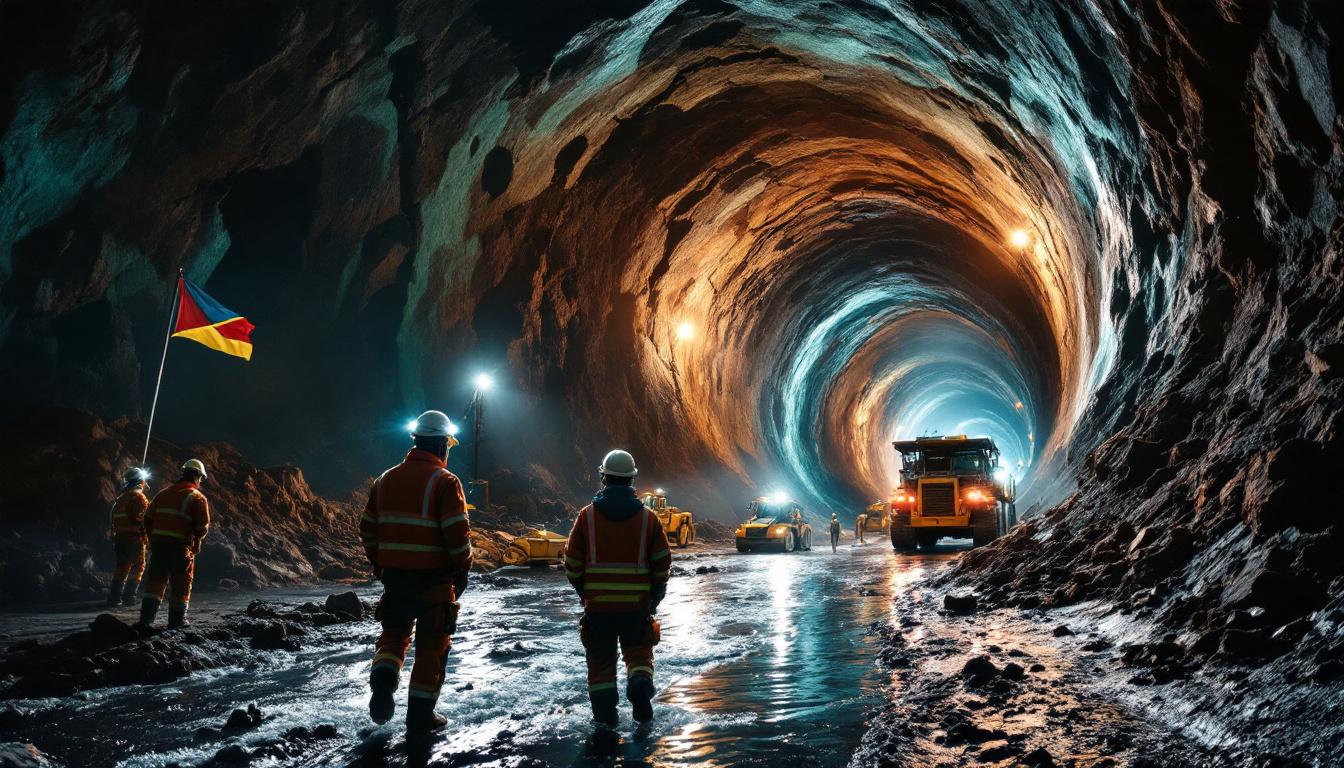Understanding Critical Minerals Stockpiles: Strategic Necessity or Wasteful Warehousing?
Critical minerals stockpiles represent government-established reserves of essential raw materials created to ensure national security, economic stability, and defense readiness. These strategic reserves have gained substantial attention as Western nations race to reduce dependence on China's dominant position in global supply chains.
The Growing Global Movement Toward Strategic Reserves
Western governments are increasingly implementing robust stockpiling programs as part of their critical minerals strategies. Australia recently announced a significant $1.2 billion stockpile initiative, alongside an additional $1 billion for its critical minerals facility, bringing the total commitment to $5 billion. This represents one of the most substantial Western investments in addressing mineral shortages to date.
Similar programs are being developed or expanded in Canada, the United States, and South Korea, all aiming to create a buffer against supply chain disruptions and reduce strategic vulnerability to foreign suppliers.
The urgency behind these stockpiling efforts stems from China's resource influence in critical mineral processing and refining. For decades, China has strategically built significant reserves while simultaneously controlling processing capabilities, creating a form of "double leverage" in global markets.
Key Minerals Targeted for Stockpiling
Government stockpiling programs primarily focus on minerals essential for both energy transition and defense applications:
- Rare earth elements (REEs) – particularly heavy rare earths like dysprosium and terbium, critical for permanent magnets in electric vehicles and wind turbines
- Battery metals – lithium, cobalt, nickel, and graphite needed for energy storage systems
- Base metals – copper and aluminum required for electrification infrastructure
- Strategic metals – gallium, germanium, and antimony, which serve specialized technological applications
These minerals have been identified as critical based on a combination of economic importance, supply risk, and potential for disruption through export controls or geopolitical tensions.
China's Existing Stockpiling Advantage
While Western nations are just beginning their stockpiling journeys, China has accumulated vast inventories over many years as part of its long-term resource security strategy. These reserves give China considerable market power and negotiating leverage:
- Stockpiling accounts for approximately 65% of China's copper demand
- About 40% of China's lithium consumption goes toward strategic reserves
- Substantial portions of aluminum and cobalt production are diverted to national stockpiles
This strategic foresight has positioned China advantageously in global markets, allowing it to weather supply disruptions while maintaining manufacturing output even during shortages.
How Do Critical Mineral Stockpiles Impact Market Dynamics?
The introduction of government stockpiles significantly alters traditional supply-demand relationships in mineral markets, with both stabilizing and potentially disruptive effects.
Price Floor Creation and Market Stabilization
Strategic stockpiling can establish effective price floors for critical minerals, particularly benefiting emerging producers of rare earth strategies and other strategic metals during market downturns. By creating guaranteed demand through government purchases, stockpiles can:
- Support domestic producers during periods of price weakness
- Reduce volatility in notoriously cyclical mineral markets
- Encourage investment in new mining and processing projects by decreasing long-term price uncertainty
- Maintain operational viability of mines that might otherwise close during downturns
For junior mining companies attempting to develop new critical mineral sources, the existence of a government buyer of last resort represents a form of insurance against market collapse.
Potential Market Distortion Risks
Despite potential benefits, financial analysts from institutions like ANZ have raised concerns about unintended consequences from aggressive stockpiling programs. Senior commodity strategists Daniel Hynes and Soni Kumari warn that poorly implemented stockpiling could lead to:
- Increased market volatility, especially when large reserves are released suddenly
- Price dislocations between regions with different stockpiling policies
- Accelerated geopolitical tensions around resource nationalism
- Supply chain disruptions if implemented without international coordination
These risks highlight the need for transparent, gradual, and predictable stockpiling approaches that market participants can factor into their business plans.
Expert Skepticism: The Warehouse Problem
Industry leaders have expressed significant doubts about the effectiveness of certain stockpiling approaches. Amanda Lacaze, CEO of Lynas Rare Earths (ASX:LYC), Australia's only commercial rare earths producer, captured this skepticism with her pointed critique: "I cannot see how the government buying oxide is going to do anything except have the government needing to build a big warehouse."
Lacaze further noted that the $1.2 billion allocated for Australia's critical minerals stockpile wouldn't even cover Lynas' full year production, questioning both the scale and impact of such initiatives. This highlights a crucial distinction between stockpiling raw materials versus investing in processing capabilities that add value and create resilient supply chains.
Why Are Governments Rushing to Establish Critical Mineral Reserves?
The accelerating pace of governmental stockpiling initiatives reflects mounting concerns about mineral security in an increasingly fragmented global trading system.
Geopolitical Tensions and Supply Chain Security
The rush to establish critical mineral reserves has intensified amid escalating trade tensions between the United States and China. With China controlling dominant portions of global supply chains, Western governments view stockpiles as a necessary defensive measure:
- China controls over 80% of the global rare earths supply chain
- More than 50% of lithium refining capacity resides in China
- Significant portions of graphite, cobalt, and other critical mineral processing occurs within Chinese borders
These concerns have been validated by China's strategic export restrictions on gallium, germanium, and antimony – critical inputs for semiconductors and defense applications. Similar restrictions on heavy rare earth exports have further alarmed Western policymakers, accelerating stockpiling efforts as insurance against future supply disruptions.
The Ukraine Connection
The United States recently finalized a critical minerals agreement with Ukraine, highlighting how mineral security has become central to international diplomacy. Ukraine reportedly holds Europe's largest undeveloped lithium reserves, making it a potential strategic partner in diversifying supply chains away from Chinese control.
This partnership illustrates how critical minerals have transcended purely economic considerations to become central elements of geopolitical market strategies and alliance formation. Similar agreements are being pursued with other resource-rich nations considered politically aligned with Western interests.
Long-Term Supply-Demand Imbalances
According to detailed analyses from ANZ and other financial institutions, current low prices present a strategic opportunity for governments to build national stockpiles cost-effectively. However, this window may be relatively short-lived, as demand is projected to exceed supply across multiple critical mineral markets by the end of the decade.
For example, lithium demand is expected to grow at over 20% annually through 2030, potentially creating severe shortages despite current oversupply conditions. This projected imbalance creates urgency for building strategic reserves while prices remain depressed.
How Do Current Market Conditions Affect Stockpiling Strategies?
The timing of stockpile acquisitions significantly impacts both their cost-effectiveness and their market impact, creating complex strategic considerations for policymakers.
Lithium Market Challenges and Opportunities
The lithium sector provides a clear illustration of the complex dynamics affecting critical minerals markets and stockpiling decisions:
- Current lithium carbonate prices hover around $8,700/t, down approximately 89% from peaks above $80,000/t in late 2022
- Albemarle, the world's largest lithium producer, estimates 40% of lithium producers are currently operating at a loss
- Approximately one-third of unprofitable operations have already suspended production
- Annual demand growth continues at over 20% despite price challenges, driven by electric vehicle battery production
This combination of depressed prices and continued demand growth creates what appears to be an ideal buying opportunity for government stockpiles, though technical considerations regarding storage and quality degradation must be addressed.
Strategic Timing for Reserve Building
Current market conditions create a potential "buy low" opportunity for government stockpiles, but this approach requires careful implementation to avoid unintended consequences:
- Purchasing during downturns can provide crucial support to struggling domestic producers
- Building reserves gradually minimizes market distortion and price spikes
- Transparent policies regarding acquisition and potential release reduce uncertainty
- Clear quality specifications ensure stockpiled materials remain commercially viable
The most effective stockpiling strategies couple market-based purchasing during price weakness with counter-cyclical release mechanisms that smooth supply disruptions without triggering price collapses.
Investment Implications for Mining Companies
The establishment of strategic reserves could significantly impact mining companies across the critical minerals sector:
- Creating guaranteed markets for production during downturns, potentially enabling more stable operational planning
- Accelerating project development timelines through improved financing conditions
- Reducing capital costs as perceived project risks decrease due to assured offtake
- Enabling development of deposits previously considered marginal due to market uncertainty
For junior miners especially, government stockpiling programs could represent the difference between project advancement and indefinite delay, particularly for minerals like rare earths where market size remains relatively small.
What Are the Different Approaches to Critical Mineral Security?
Nations are pursuing diverse approaches to critical mineral security, reflecting different resource endowments, industrial capabilities, and geopolitical priorities.
Direct Stockpiling vs. Supply Chain Development
Governments are pursuing multiple strategies to secure critical mineral supplies:
- Direct stockpiling – physically purchasing and storing materials for future use
- Production incentives – providing tax benefits, grants, and subsidies for domestic mining
- Processing development – funding for refining and manufacturing capabilities
- International partnerships – agreements with allied nations for mineral supply security
The most comprehensive national strategies typically combine elements of all four approaches, recognizing that physical stockpiles alone cannot resolve structural vulnerabilities in mineral supply chains.
Regional Implementation Differences
Different regions have adopted varying approaches to critical minerals security based on their specific circumstances:
- Australia: Implemented a $1.2 billion stockpile initiative plus $5 billion critical minerals facility, leveraging its position as a major producer of many critical minerals
- United States: Revitalized the national defense stockpile while simultaneously funding domestic processing through the Inflation Reduction Act and Defense Production Act
- Canada: Focused on targeted stockpiling of rare earth minerals from new projects while providing generous tax incentives for exploration
- European Union: Prioritized the Critical Raw Materials Act focused on supply chain development rather than formal stockpiles, reflecting the EU's limited domestic production
- South Korea: Established strategic reserves of rare earth minerals while developing technological alternatives to reduce dependency
These different approaches highlight how mineral security strategies must be tailored to each nation's specific vulnerabilities, capabilities, and industrial priorities.
What Are the Long-Term Implications of Critical Mineral Stockpiles?
The emergence of significant government stockpiles could fundamentally reshape the structure and functioning of global critical mineral markets over the coming decades.
Supply Chain Restructuring
Strategic reserves could catalyze profound changes in global critical mineral supply chains by:
- Accelerating the development of non-Chinese supply sources through guaranteed offtake
- Creating regional processing hubs aligned with political alliances rather than purely economic factors
- Establishing more transparent pricing mechanisms with greater government participation
- Reducing the concentration of market power currently held by Chinese entities
These changes could potentially lead to a more resilient, though possibly less economically efficient, global system for critical mineral production and distribution.
Price Impact Scenarios
ANZ analysts suggest several potential market outcomes from widespread stockpiling initiatives:
- Establishment of sustained price floors for targeted minerals, creating more predictable investment environments
- Reduced price volatility in normal market conditions as government purchases buffer supply-demand mismatches
- Potential for sharp corrections when reserves are released during supply crises
- Emergence of regional price differentials based on differing stockpile policies and release mechanisms
These price effects would likely vary significantly by mineral, with smaller markets (such as rare earths) more susceptible to distortion than larger, more liquid markets like copper.
Future Industry Structure
The stockpiling trend may contribute to a two-tier market structure for critical minerals:
- Strategic materials with government price support and guaranteed offtake, creating stable but potentially less dynamic market segments
- Commercial materials subject to traditional market forces, with greater volatility but also greater innovation incentives
- Hybrid arrangements with partial government backing through conditional purchase agreements and minimum price guarantees
This bifurcation could create significant strategic advantages for companies positioned to serve both government and commercial markets with flexible production capabilities.
Critical Mineral Stockpiles: Balancing Security and Market Function
The global movement toward critical mineral stockpiling represents a fundamental shift in how governments approach resource security. While stockpiles can provide insurance against supply disruptions and support domestic production during market downturns, they also risk distorting markets and potentially wasting resources if poorly implemented.
The most effective approaches combine strategic stockpiling with investments in domestic processing capabilities, international partnerships, and technological innovation to reduce dependency on concentrated supply sources. As Amanda Lacaze of Lynas aptly noted, governments should avoid simply building "big warehouses" of raw materials without addressing the fundamental processing and manufacturing capabilities that truly create supply chain resilience.
As critical mineral markets continue to evolve, the interaction between government stockpiles and commercial markets will shape investment decisions, technological development, and international relations. Companies and investors positioned to understand and navigate this complex landscape will find both challenges and opportunities in the new era of strategic resource management and commodities market insights.
Note: Critical mineral markets remain highly dynamic, with conditions changing rapidly in response to technological developments, policy changes, and geopolitical events. Investors should conduct thorough due diligence and consult qualified advisors before making investment decisions related to critical minerals stockpile sector.
Want to Capitalise on the Next Major Mineral Discovery?
Stay ahead of the market with Discovery Alert's proprietary Discovery IQ model, which instantly notifies investors of significant ASX mineral discoveries and transforms complex data into actionable insights. Explore why historic discoveries can generate substantial returns by visiting Discovery Alert's dedicated discoveries page and begin your 30-day free trial today.




